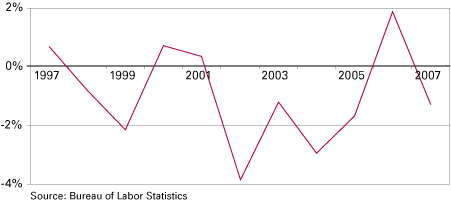Muncie
Director, Bureau of Business Research; Associate Professor of Economics, Ball State University, Muncie
Muncie's economy was rocked hard by the 2001 recession and the subsequent employment losses that swept the upper Midwest. Happily, it appears as if the employment declines and attendant out-migration have slowed considerably. As a result, we predict that 2008 will be a bottoming-out year for employment in Muncie. Here's what to expect.
First, as the rapid job losses plateau out, population declines—which have plagued the region over the past decade and a half—will dampen. Delaware County should see a population in 2010 just modestly above its 1990 Census of roughly 119,000. This estimate is consistent with some academic forecasters (1) who predict modest population growth for the area, and it is a significant turnaround from the 5,000 person drop in population between 1990 and 2000. A slowdown in economic out-migration, along with an increase in natural growth will aid in the region's population growth. Interestingly, net international migration is a small but growing contributor to the Muncie area population.
Employment loss in Delaware County has slowed to a trickle (see Figure 1). This trend largely mimics those counties adjoining Delaware County. The most recent data on net employment changes (job gains minus losses) suggest that 2006 to 2007 job losses hovered near zero for the second year in a row. The nearly static net employment changes mask a considerable turnover rate in employment. In the past four quarters, roughly one in ten jobs in the county went vacant and were later filled. This turbulence is a little less than the state or national average, but certainly reflects the state of employment dynamics in today's economy.
Figure 1
Percent Change in Total Employment from Previous September in Delaware County

The health care and social services sector is one part of the economy that has changed dramatically. Growth has been almost sufficient enough to absorb modest job losses across the remaining sectors. The heaviest job losses have occurred in manufacturing and accommodations and food services. The impending closure of the Borg-Warner plant in Muncie (due by early 2009) will cost the area roughly 750 more manufacturing jobs. This is likely to be among the last of a long string of major plant closures in the region.
The sectoral shift away from more capital-intensive activities, such as manufacturing, to more labor-intensive industries, such as health care, is reflected in earnings data. Across the board, earnings for existing employees have declined modestly (by about one-third of a percent), while earnings for new hires have risen. This wage differential likely reflects the loss of jobs held by employees with longer job tenure (typically a manufacturing worker). The new hires occur in sectors with increasing human capital demands (hence higher starting wages than in years past).
Health care sector growth, including the recent announcement for Clarian Healthcare in Delaware County, will likely extend the trend of switching from capital-intensive to labor-intensive industries far beyond 2008.
Finally, Delaware County residents have made great strides in educational attainment. Nothing else in the region will be as influential in the coming years as a ready pool of educated and healthy workers for prospective businesses. The percent of adults who graduated high school rose, as did the percent of adults who graduated college. In fact, Delaware County is above the state and national average in both metrics. Most importantly, however, is the direction of recent high school graduates. In 1996, fewer than 70 percent of Delaware County high school students reported plans for college at graduation. That rate rose 20 percentage points by 2006; now, nearly nine out of ten Delaware County high school graduates have college plans.
The Muncie area, like most other mid-sized cities in the upper Midwest, has been buffeted by hard economic times over the past two decades. The large-scale job losses appear to have largely run their course and the face of the new economy is emerging. The coming year will bring more news confirming this transformation. The educational attainment and industry trends should be viewed as heartening news for the region.
Note
- Derived from Peter Linneman and Albert Saiz, “Forecasting 2020 U.S. County and MSA Populations” (working paper 572, Samuel Zell and Robert Lurie Real Estate Center at Wharton, Wharton University of Pennsylvania).
Also in this Issue…
- Outlook for 2008
- The International Economy
- The U.S. Economy
- Financial Forecast
- Housing
- Indiana Agriculture
- Indiana
- Anderson
- Bloomington
- Columbus
- Evansville
- Fort Wayne
- Gary
- Indianapolis-Carmel
- Kokomo
- Louisville
- Muncie
- Richmond
- South Bend-Mishawaka and Elkhart-Goshen
- Terre Haute
- Return to Table of Contents



